The Existence of Muhammadiyah in Education to Fulfill The Promise of Independence in East Nusa Tenggara
DOI:
https://doi.org/10.22219/jms.v9i1.13770Keywords:
Ahmad Dahlan; Muhammadiyah; Education; Independence; East Nusa Tenggara.Abstract
This article describes and explains Muhammadiyah's contribution to East Nusa Tenggara. The figure of KH. Ahmad Dahlan, with the Muhammadiyah organization, has answered every need of society, from Islamic renewal to working in the social, preaching, and education sectors. Muhammadiyah has eradicated backwardness, poverty, and ignorance and carried out total resistance against formalism and religious conservatism by breaking down "TBC" (Tahayul, Bid'ah, and Churafat). Because Muhammadiyah truly believes that Islam is a religion that contains progressive values. East Nusa Tenggara is known as an archipelago province because it consists of many islands. The number is more than 500 large and small islands, both named and unnamed. The large islands include Flores Island, Lembata, Sumba, and Alor. The islands that are relatively small and have names include Semau Island, Rinca, Komodo, Permaan, Kojadoi, and many more. The people of East Nusa Tenggara (well known as NTT) are mostly Catholic Christians, more than 55%, Protestant Christians, around 35%, and Muslims, only around 10%. Muhammadiyah locally has an organizational agenda as a response to the conditions of the people in remote areas of the country. While nationally, there is a special agenda related to the needs of the organization. This article uses qualitative methods to analyze the data related to the topics. As a finding, since the beginning of its existence, Muhammadiyah has indeed been intended as a da'wah institution that focuses on strengthening the capacity of the people. Muhammadiyah, in carrying out its mission to educate the nation's generations both before and after independence, can provide an image to the NTT community that Muhammadiyah has actually contributed to fulfilling the promises of independence. This can also be felt by the NTT community, especially in the fields of education, health, and social. This is proven by Muhammadiyah establishing schools, orphanages, and health clinics. Muhammadiyah has contributed a lot to upholding this country on its path. The strength and spirit that have been rooted since 1912 have been able to survive and continue to exist in this beloved country.
Downloads
References
Achied, Zainudin. 2011. The Struggle of Muhammadiyah NTT. Kupang. UMK Press
. 2014. History of Kupang University, Travel Notes22 September 1987-22 September 2014. Kupang.
Barulazi, B., Wekke, IS, & Rais, M. (2019, June 13). Muhammadiyah Da'wah Movement in Sorong City. https://doi.org/10.31227/osf.io/hycdg.
Burhani, AN (2006). The ideological shift of Muhammadiyah from cultural into puritanical tendency in the 1930s. Journal of Society and Culture, 8(1), 1-22.
(2011). Lakum dīnukum wa-liya dīnī: the Muhammadiyah's stance towards interfaith relations. Islam and Christian–Muslim Relations, 22(3), 329-342.
Central Leadership of Muhammadiyah. 2018. Tanfidz Decision of the 47th Muhammadiyah Congress. Yogyakarta: Central Leadership of Muhammadiyah. Accessed from hhtp://www.muhammadiyah.or.id/muhfile/download/TANFIDZ%MUKTAMAR%47.pdf
Cooper, Jemas M. (ed) 1990. Classroom teaching – Learning Process. New Delhi, Vikas Publishing House and. PVT LTD.
Danius, EE (2012). Christian-Islamic relations after the conflict in Tobelo, North Halmahera. Uniera Journal, 1(1).
Facer, Keri. 2011. Learning Futures. Education, Technology and Social Change. Routledge: New York
Kupang statistical data accessed from https://kupangkab.bps.go.id/ Kupang Regency in Figures 2013 on March 23, 2020.
Latief, H. (2013). Religion and Social Services; Interpretation and Action of Philanthropy in Muslim and Christian Traditions in Indonesia. Journal of Religion, 9(2), 174-189.
Law Number 20 of 2003 concerning the National Education System, published by the National Information Institute, Jakarta.
Mu'ti, A., & Haq, FRU (2009). Christian Muhammadiyah: Muslim and Christian convergence in education. Al-Wasat Publishing House.
Mulyasa, E. 2015. Mental Revolution. Bandung. Rosdakarya
Sanjaya, Wian. 2006. Learning Strategy. Jakarta. Kencana Prenadamedia Group
Tahang, H., Wekke, IS, & Fatimah, F. (2019, June 13). Muhammadiyah's Da'wah Through Educational Institutions. https://doi.org/10.31227/osf.io/scjnq.
Tholkah, Imam and Mursyid Ali (eds). 2002. Social Conflict with Religious Nuances in Indonesia. Jakarta: Center for Research and Development of Religious Life – Research and Development and Training Agency of the Ministry of Religion.
Tholkhah, Imam. 2008. Humans, Religion and Peace. Jakarta: Alghazali
Tilaar, HAR 2016. Our Teacher “Character and Intelligence Artist”. Yogyakarta. Lamalera
Wekke, IS, Arif, B., Zubair, A., & Wardi, M. (2019). The Role of Muhammadiyah Institution Towards Muslim Minority in West Papua. Peuradeun Scientific Journal, 7(1), 21-42. Wekke, IS, Barulazi, B., Rais, M., & Idris, I. (2019, June 13). Acceleration of Muhammadiyah's Da'wah Movement in the Muslim Minority Region of West Papua. https://doi.org/10.31227/osf.io/7n9bj. Tadarus Thoughts of the Muhammadiyah Young Intellectual Network (JIMM), University of Muhammadiyah Malang, May 23-24, 2018.
Yakin, Ainul. 2005. Multicultural Education – Cross-Cultural Understanding for Democracy and Justice, Jakarta: Pilar.
Downloads
Published
How to Cite
Issue
Section
License
Copyright (c) 1970 Amirulah Datuk Amirulah Datuk

This work is licensed under a Creative Commons Attribution 4.0 International License.
Copyright Notice
Authors who publish with Jurnal Muhammadiyah Studies agree to the following terms:
- For all articles published in the Jurnal Muhammadiyah Studies, copyright is retained by the authors. Authors give permission to the publisher to announce the work with conditions. When the manuscript is accepted for publication, the authors agree to the automatic transfer of the publishing right to the publisher.
- Authors retain copyright and grant the journal the right of first publication with the work simultaneously licensed under a Creative Commons Attribution 4.0 International License. that allows others to share the work with an acknowledgment of the work's authorship and initial publication in this journal.
- Authors are able to enter into separate, additional contractual arrangements for the non-exclusive distribution of the journal's published version of the work (e.g., post it to an institutional repository or publish it in a book), with an acknowledgment of its initial publication in this journal.
- Authors are permitted and encouraged to post their work online (e.g., in institutional repositories or on their website) prior to and during the submission process, as it can lead to productive exchanges, as well as earlier and greater citation of published work (See The Effect of Open Access).




